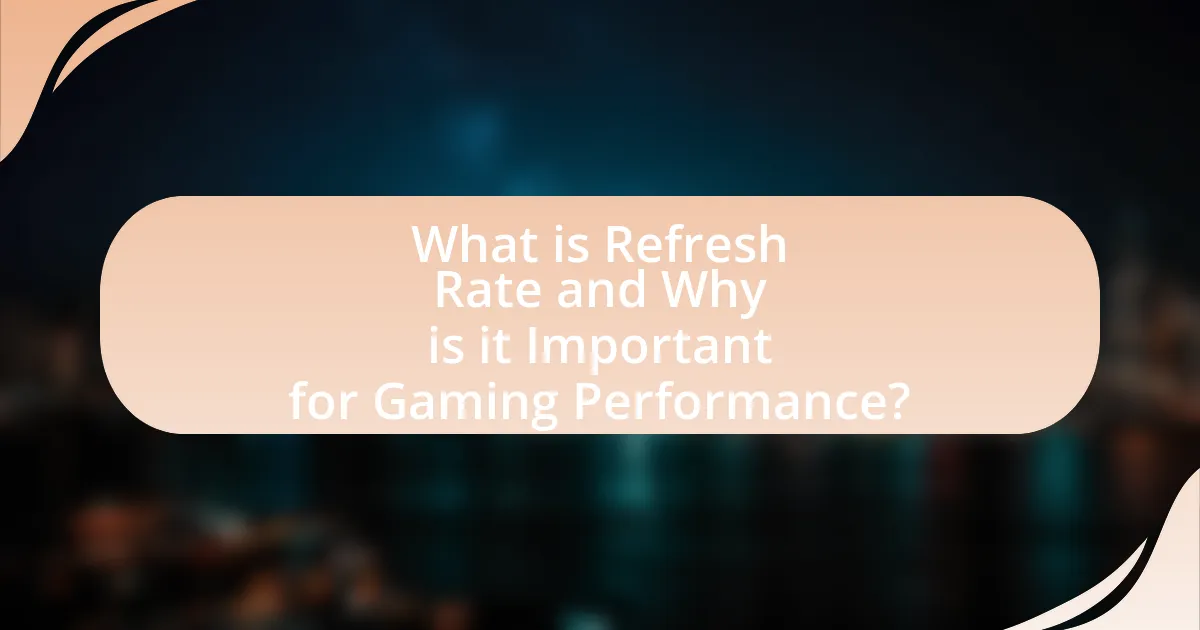Refresh rate, measured in hertz (Hz), is a critical factor in gaming performance, indicating how many times a display updates its image per second. Higher refresh rates, such as 144Hz or 240Hz, lead to smoother motion, reduced motion blur, and improved responsiveness, which are essential for fast-paced gaming. The article explores the definition of refresh rate in gaming, its impact on visual clarity and input lag, and how it influences different types of games. It also discusses the hardware requirements for achieving higher refresh rates, best practices for optimizing refresh rate settings, and common issues gamers may encounter, such as screen tearing and stuttering. Understanding these aspects is vital for gamers seeking to enhance their overall gaming experience and performance.

What is Refresh Rate and Why is it Important for Gaming Performance?
Refresh rate is the number of times a display updates its image per second, measured in hertz (Hz). It is crucial for gaming performance because a higher refresh rate leads to smoother motion and reduced motion blur, enhancing the overall gaming experience. For instance, a display with a refresh rate of 144 Hz can show 144 frames per second, which is significantly smoother than a 60 Hz display. This increased fluidity allows gamers to react more quickly to in-game actions, providing a competitive advantage, especially in fast-paced games. Studies have shown that higher refresh rates can improve player performance and satisfaction, making refresh rate a key factor in gaming setups.
How is Refresh Rate Defined in the Context of Gaming?
Refresh rate in the context of gaming is defined as the number of times a display updates its image per second, measured in hertz (Hz). A higher refresh rate, such as 120Hz or 240Hz, allows for smoother motion and improved responsiveness during gameplay, which can enhance the overall gaming experience. Studies indicate that displays with higher refresh rates can reduce motion blur and provide a competitive advantage in fast-paced games, as players can react more quickly to on-screen action.
What are the standard refresh rates available for gaming monitors?
The standard refresh rates available for gaming monitors are typically 60Hz, 120Hz, 144Hz, 165Hz, 240Hz, and 360Hz. These refresh rates indicate how many times per second the monitor updates the image displayed. For instance, a 144Hz monitor refreshes the image 144 times per second, providing smoother motion and improved responsiveness compared to lower refresh rates. High refresh rates, such as 240Hz and 360Hz, are particularly favored in competitive gaming, as they can enhance the gaming experience by reducing motion blur and input lag.
How does refresh rate differ from frame rate?
Refresh rate refers to the number of times a display updates its image per second, measured in hertz (Hz), while frame rate indicates the number of frames per second (fps) that a graphics card renders. For example, a monitor with a refresh rate of 60 Hz can display up to 60 updates per second, whereas a game running at 120 fps generates 120 frames in the same time frame. This distinction is crucial because a higher refresh rate can lead to smoother visuals, but if the frame rate is lower than the refresh rate, the excess refresh cycles do not contribute to improved performance. Thus, while both metrics influence visual experience, they operate independently, with refresh rate focusing on display capabilities and frame rate on content generation.
Why Does Refresh Rate Matter in Gaming?
Refresh rate matters in gaming because it directly affects the smoothness and responsiveness of gameplay. A higher refresh rate, such as 144Hz or 240Hz, allows for more frames to be displayed per second, resulting in a clearer and more fluid visual experience. This is particularly important in fast-paced games where quick reactions are crucial; studies show that players using monitors with higher refresh rates can achieve better performance and accuracy. For instance, competitive gamers often prefer 240Hz displays to gain a competitive edge, as they can see and react to in-game events more swiftly than those using standard 60Hz monitors.
How does refresh rate affect visual clarity and smoothness in gameplay?
Refresh rate significantly impacts visual clarity and smoothness in gameplay by determining how many frames per second a monitor can display. A higher refresh rate, such as 144Hz or 240Hz, allows for smoother motion and reduces motion blur, resulting in clearer visuals during fast-paced action. This is particularly important in competitive gaming, where quick reactions are crucial; studies show that players using monitors with higher refresh rates can respond faster and track moving objects more effectively. For instance, a 2019 study published in the Journal of Vision found that participants performed better in tracking tasks on displays with higher refresh rates, confirming the correlation between refresh rate and visual performance in gaming contexts.
What impact does refresh rate have on input lag and responsiveness?
Refresh rate significantly impacts input lag and responsiveness in gaming. A higher refresh rate, such as 144Hz or 240Hz, allows the display to update the image more frequently, which reduces the time between the input from the user (like pressing a button) and the corresponding action appearing on the screen. This reduction in time leads to a more responsive gaming experience, as players can react more quickly to in-game events. Studies have shown that displays with higher refresh rates can reduce input lag by up to 50% compared to standard 60Hz displays, enhancing overall gameplay fluidity and precision.

How Does Refresh Rate Influence Different Types of Games?
Refresh rate significantly influences gaming performance by determining how many frames per second a monitor can display, which directly affects visual fluidity and responsiveness. In fast-paced games, such as first-person shooters and racing games, higher refresh rates (144Hz or more) provide smoother motion and reduce motion blur, enhancing player reaction times and overall experience. Conversely, in slower-paced games like turn-based strategy or role-playing games, a standard refresh rate (60Hz) may suffice, as the emphasis is less on rapid movements and more on strategic decision-making. Studies indicate that players using higher refresh rates in competitive gaming scenarios often achieve better performance metrics, such as accuracy and reaction times, reinforcing the importance of refresh rate in optimizing gameplay.
What are the effects of refresh rate on fast-paced games?
The refresh rate significantly affects the performance and experience of fast-paced games by determining how many frames per second the display can show. Higher refresh rates, such as 120Hz or 240Hz, provide smoother motion and reduce motion blur, which is crucial in fast-paced gaming scenarios where quick reactions are necessary. Studies indicate that players using monitors with higher refresh rates experience improved responsiveness and accuracy, leading to better performance in competitive gaming environments. For instance, a study by the University of Utah found that players with a 120Hz display had a 30% improvement in reaction times compared to those using a 60Hz display. This enhancement in visual clarity and responsiveness can be the difference between winning and losing in fast-paced games.
How does refresh rate enhance competitive gaming experiences?
Refresh rate enhances competitive gaming experiences by providing smoother motion and reducing input lag, which allows players to react more quickly to in-game events. A higher refresh rate, such as 144Hz or 240Hz, displays more frames per second, resulting in clearer visuals during fast-paced action. This clarity enables players to track moving targets more effectively and make precise movements, which is crucial in competitive scenarios. Studies have shown that gamers using monitors with higher refresh rates report improved performance and responsiveness, leading to better overall outcomes in competitive matches.
What is the role of refresh rate in immersive single-player games?
The refresh rate plays a crucial role in immersive single-player games by determining how many frames per second the display can show, directly affecting visual fluidity and responsiveness. A higher refresh rate, such as 120Hz or 144Hz, allows for smoother motion and reduces motion blur, enhancing the player’s experience and immersion. Studies indicate that players often perceive a more responsive and engaging gameplay experience at higher refresh rates, as it minimizes input lag and provides clearer visuals during fast-paced action. This improvement in visual performance can lead to better gameplay outcomes, as players can react more quickly to in-game events.
How do Different Refresh Rates Affect Gaming Hardware?
Different refresh rates significantly impact gaming hardware performance by influencing the smoothness of motion and responsiveness in gameplay. Higher refresh rates, such as 144Hz or 240Hz, allow for smoother visuals and reduced motion blur, which enhances the gaming experience, particularly in fast-paced games. This improvement is due to the increased number of frames displayed per second, allowing the graphics card to deliver more fluid motion.
For instance, a study by NVIDIA found that gamers using monitors with higher refresh rates experienced a competitive advantage in first-person shooters, as they could react more quickly to on-screen action. Additionally, gaming hardware, including graphics cards and monitors, must be compatible with higher refresh rates to fully utilize their benefits; otherwise, performance may be bottlenecked. Thus, the choice of refresh rate directly affects both the visual experience and the overall performance of gaming hardware.
What are the hardware requirements for achieving higher refresh rates?
To achieve higher refresh rates, a monitor capable of supporting those rates, a powerful graphics processing unit (GPU), and sufficient system memory are essential. Monitors designed for higher refresh rates, such as 120Hz or 240Hz, can display more frames per second, enhancing visual fluidity. A high-performance GPU is necessary to render graphics quickly enough to match the monitor’s refresh rate; for instance, GPUs like the NVIDIA GeForce RTX 30 series or AMD Radeon RX 6000 series are optimized for high refresh rates in gaming. Additionally, having at least 16GB of RAM ensures that the system can handle the data throughput required for high-performance gaming, preventing bottlenecks that could hinder frame rates.
How does the graphics card impact refresh rate performance?
The graphics card directly influences refresh rate performance by determining how many frames per second (FPS) it can render, which correlates with the monitor’s refresh rate. A higher-performing graphics card can produce more frames, allowing for smoother visuals and reducing screen tearing when the FPS exceeds the refresh rate. For instance, a graphics card capable of rendering 144 FPS will fully utilize a 144Hz monitor, providing an optimal gaming experience. Conversely, if the graphics card can only render 30 FPS, a 144Hz monitor cannot display its full potential, leading to a less fluid experience. This relationship is crucial for gamers seeking high performance, as the graphics card’s capabilities dictate the maximum achievable refresh rate performance.

What Are the Best Practices for Optimizing Refresh Rate in Gaming?
To optimize refresh rate in gaming, players should use a monitor with a high refresh rate, ideally 144Hz or higher, and ensure their graphics card can support this rate. High refresh rates reduce motion blur and provide smoother gameplay, enhancing the overall gaming experience. Additionally, enabling V-Sync or G-Sync can help synchronize the frame rate with the refresh rate, preventing screen tearing. Regularly updating graphics drivers and adjusting in-game settings to balance performance and visual quality also contribute to maintaining an optimal refresh rate. Studies show that higher refresh rates can significantly improve reaction times and accuracy in competitive gaming scenarios.
How can gamers ensure they are utilizing the optimal refresh rate?
Gamers can ensure they are utilizing the optimal refresh rate by adjusting their display settings to match the maximum refresh rate supported by their monitor and graphics card. This can be done through the display settings in the operating system or graphics control panel, where users can select the highest available refresh rate, typically 60Hz, 120Hz, or 144Hz, depending on the hardware. Research indicates that higher refresh rates lead to smoother gameplay and reduced motion blur, enhancing the overall gaming experience. For example, a study by NVIDIA found that increasing the refresh rate from 60Hz to 144Hz can significantly improve responsiveness and visual clarity in fast-paced games.
What settings should be adjusted in-game to maximize refresh rate benefits?
To maximize refresh rate benefits in-game, players should adjust settings such as frame rate limit, V-Sync, and graphics quality. Setting the frame rate limit to match or exceed the monitor’s refresh rate ensures smoother gameplay. Disabling V-Sync can reduce input lag, allowing for quicker response times, which is crucial in fast-paced games. Additionally, lowering graphics quality settings can help maintain higher frame rates, ensuring that the game runs smoothly at the monitor’s refresh rate. These adjustments collectively enhance the gaming experience by reducing stutter and improving responsiveness.
How can monitor settings be configured for the best refresh rate experience?
To configure monitor settings for the best refresh rate experience, set the refresh rate to the highest supported value in the display settings of your operating system. This can typically be done by navigating to the display settings, selecting the monitor, and adjusting the refresh rate option. For example, many gaming monitors support refresh rates of 144Hz or higher, which significantly enhances motion clarity and reduces input lag during gameplay. Additionally, ensure that the graphics card drivers are up to date, as this can affect the ability to utilize higher refresh rates effectively.
What Common Issues Might Gamers Encounter with Refresh Rate?
Gamers commonly encounter issues such as screen tearing, stuttering, and input lag related to refresh rate. Screen tearing occurs when the refresh rate of the monitor is out of sync with the frame rate of the game, leading to visual artifacts. Stuttering happens when the frame rate fluctuates, causing uneven motion, which can be exacerbated by a low refresh rate. Input lag refers to the delay between a player’s action and the corresponding on-screen response, which can be more pronounced at lower refresh rates. These issues can significantly affect gaming performance and overall experience, as studies indicate that higher refresh rates (e.g., 144Hz or 240Hz) provide smoother gameplay and reduce these problems compared to standard 60Hz displays.
How can screen tearing and stuttering be resolved?
Screen tearing and stuttering can be resolved by enabling V-Sync or using adaptive sync technologies like G-Sync or FreeSync. V-Sync synchronizes the frame rate of the game with the monitor’s refresh rate, preventing the display from showing parts of multiple frames simultaneously, which causes tearing. Adaptive sync technologies dynamically adjust the monitor’s refresh rate to match the frame rate output of the graphics card, effectively eliminating both tearing and stuttering. Studies show that implementing these technologies can significantly enhance the gaming experience by providing smoother visuals and reducing latency.
What troubleshooting steps can be taken if the refresh rate is not performing as expected?
To troubleshoot issues with refresh rate performance, first ensure that the display settings match the monitor’s native refresh rate. Access the display settings on your operating system and verify that the refresh rate is set correctly, typically found under “Display” or “Screen Resolution” settings. If the refresh rate is still not performing as expected, update the graphics drivers to the latest version, as outdated drivers can cause compatibility issues. Additionally, check the connection cables; using a high-quality HDMI or DisplayPort cable is essential for achieving higher refresh rates. If problems persist, test the monitor on a different device to rule out hardware issues. Lastly, consider adjusting in-game settings, as some games may limit refresh rates based on performance settings.
What Tips Can Enhance Gaming Performance Related to Refresh Rate?
To enhance gaming performance related to refresh rate, players should ensure their monitor supports a high refresh rate, ideally 144Hz or higher, as this provides smoother visuals and reduces motion blur. Additionally, enabling V-Sync or G-Sync can help synchronize the frame rate with the refresh rate, minimizing screen tearing. Furthermore, optimizing in-game settings to achieve a consistent frame rate that matches the monitor’s refresh rate can significantly improve the gaming experience. Studies show that higher refresh rates can lead to better reaction times and overall performance in competitive gaming scenarios, as players can perceive motion more fluidly.